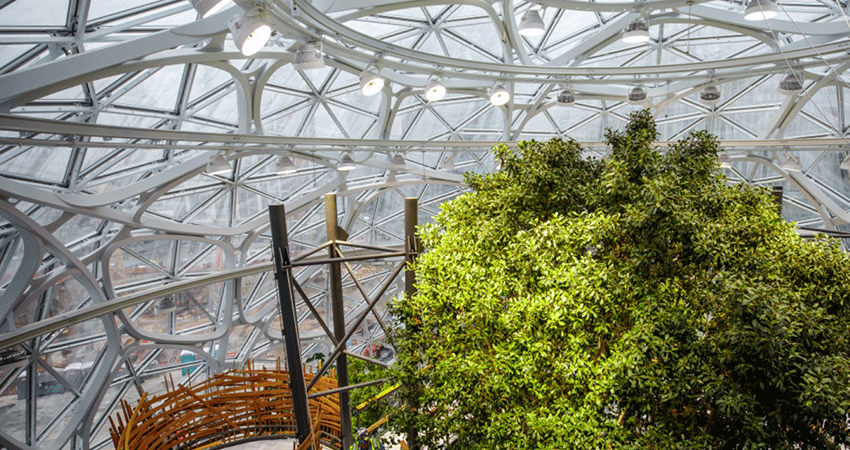Amazon posted a blowout quarter, with net sales up 11% in Q2 and upgraded fulfillment, analysts cheering and a plan in place that refocuses on same-day delivery, but the ecommerce leader still needs to find ways to improve a grocery business that is getting failing marks from industry observers.
Amazon did particularly well on the bottom line, with net income of $6.7 billion or 65 cents per diluted share, compared to a $2 billion loss a year ago and a big win vs. an analyst consensus estimate of 35 cents per share. It was also double the Q2 net income of $3.2 billion. A couple rounds of layoffs totaling 27,000 in the past year certainly helped in that respect.
“Amazon reported strong Q2 results, alleviating some fears about AWS growth, and also confirming there are meaningful improvements in operating efficiency in the fulfillment network,” Baird analyst Colin Sebastian wrote in a note to clients.
Q2 operating margin was 5.7%, ahead of the consensus of 3.46%, and operating income was $7.68 billion vs. a consensus figure of $4.72 billion. Net sales increased 11% to $134.4 billion, well ahead of the consensus of $131.6 billion and better than Q1 growth of 9%. Ecommerce revenue was up 3.7% to $53 billion.
AWS and Generative AI
Revenue for Amazon Web Services, long a profit center for the company, was up 12.2% and ahead of “high-single-digit whispers” per Baird analysts. Still, it was the lowest growth since the company began breaking out AWS results in 2015, according to the Wall Street Journal. AWS is still by far the dominant player in cloud computing, with an estimated 32% of the market compared to 23% for Microsoft Azure and 9% for Google Cloud, per Canalys as reported by Yahoo Finance.
On the generative AI front, Sebastian said that Amazon management told analysts they “(don’t) expect GenAI to move the needle meaningfully near term.”
“It was another strong quarter of progress for Amazon,” said CEO Andy Jassy in an earnings release. “We continued lowering our cost to serve in our fulfillment network, while also providing Prime customers with the fastest delivery speeds we’ve ever recorded.”
Regarding AWS, Jassy said its growth has “stabilized,” as customers shift from “cost optimization to new workload deployment.”
“AWS has continued to add to its meaningful leadership position in the cloud with a slew of generative AI releases that make it much easier and more cost-effective for companies to train and run models,” he said.
Fulfillment Overhaul Paying Off
Last week, Amazon CEO of Worldwide Amazon Stores Doug Herrington shared in a blog post that more than half of Prime members in the 60 largest U.S. metro areas got their orders on the same day or next day. “So far this year, we’ve delivered more than 1.8 billion units to U.S. Prime members the same or next day, nearly four times what we delivered at those speeds by this point in 2019,” Herrington said.
Amazon likely felt the sting of criticism that it had lost its same-day mojo during and after the pandemic, and has worked hard to restore it.
The performance improvement was attributed to a regionalization of Amazon’s fulfillment network put in place over the past year or so, with more than 75% of orders coming from within the customer’s region. Amazon uses machine learning algorithms to predict where orders will come from and for what products, to optimize its inventory placement. The company also plans to double its footprint of same-day delivery from the current 90 locations to over 180.
Amazon executives told analysts the fulfillment network overhaul has resulted in 20% fewer touches and miles traveled per order, as well as declining shipping expenses as a percentage of revenues.
Grocery Still a Problem Area
The company has also been working to retool its grocery business, laying off hundreds last month from its Amazon Fresh operations while redesigning the Fresh store format with new-look locations rolled out in Chicago. And for the first time, Amazon will offer grocery deliveries to customers who are not Prime members in select cities, in an effort to increase sales. Grocery results are not broken out in its financials.
Some observers wonder how this opening up of grocery delivery will succeed as non-Prime shoppers are less likely, in socioeconomic terms, to opt for delivery fees that are higher than those for members.
Sebastian said Jassy reaffirmed Amazon’s commitment to grocery on the call, with the CEO adding the new Fresh store format “would need to prove viable before a broader expansion.”
“We note the company’s regional and local fulfillment infrastructure could also provide delivery options in non-perishable and essentials categories,” Sebastian said.
David Silverman, Senior Director of Fitch Ratings, said Amazon’s strong quarter was helped by supply chain and other cost pressures easing, and he was encouraged by positive guidance calling for good top and bottom-line growth in Q3.
“We continue to project 2023 as a year of improved profitability across much of retail despite revenue deceleration as the cost picture improves from a very challenging year,” Silverman said. “Amazon, given its strong execution and exposure to fast-growing categories like ecommerce, cloud computing and online advertising, should be able to continue its positive growth trajectory in the near-term despite some softness in consumer goods and business spending.”

